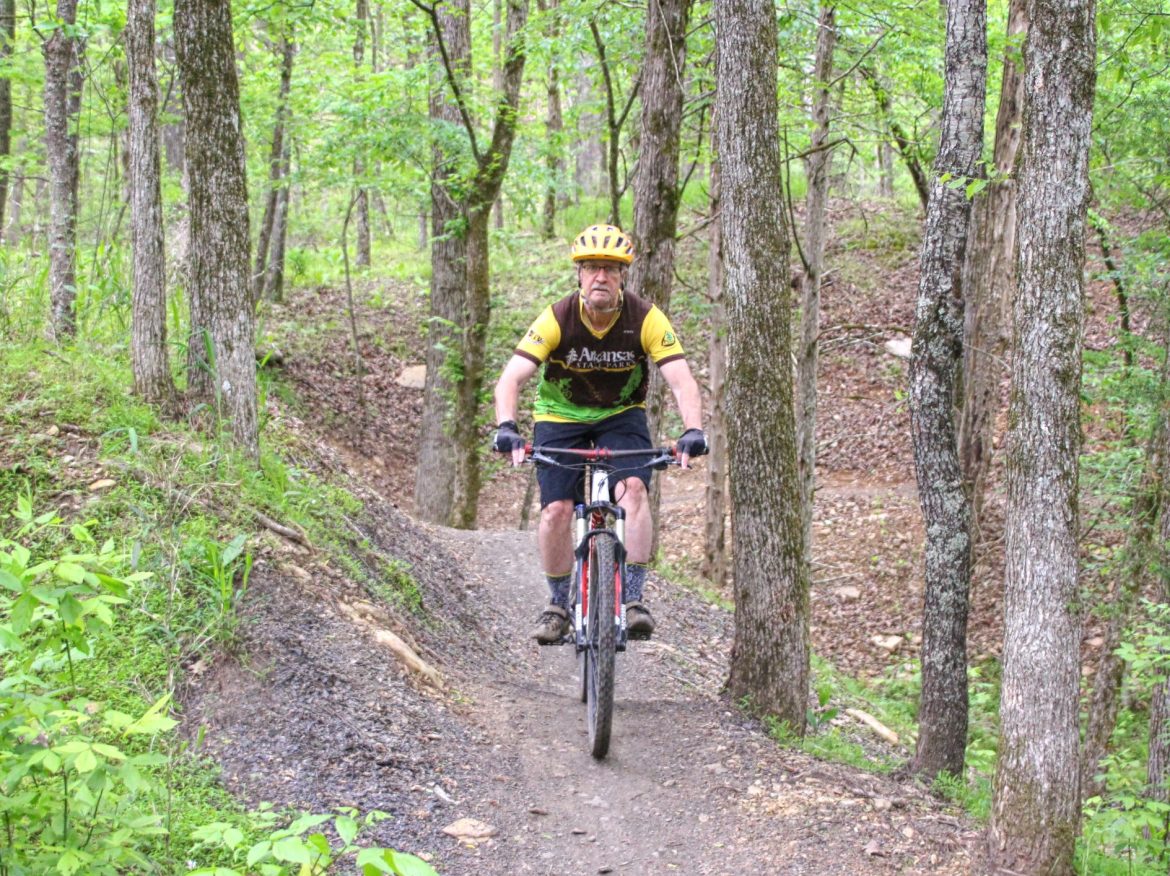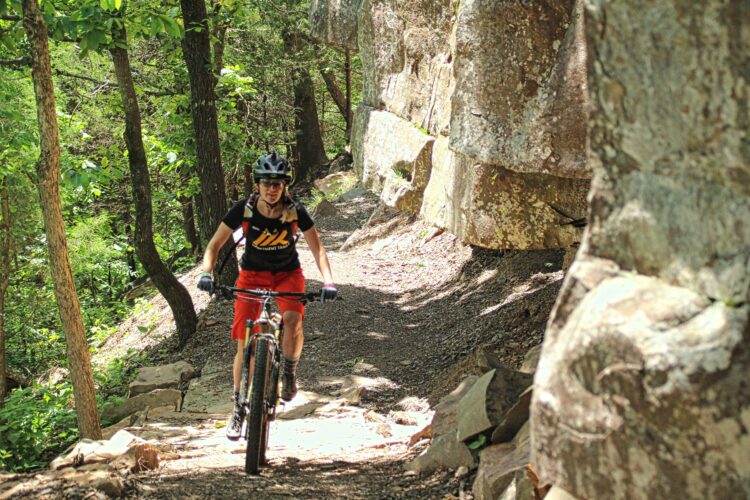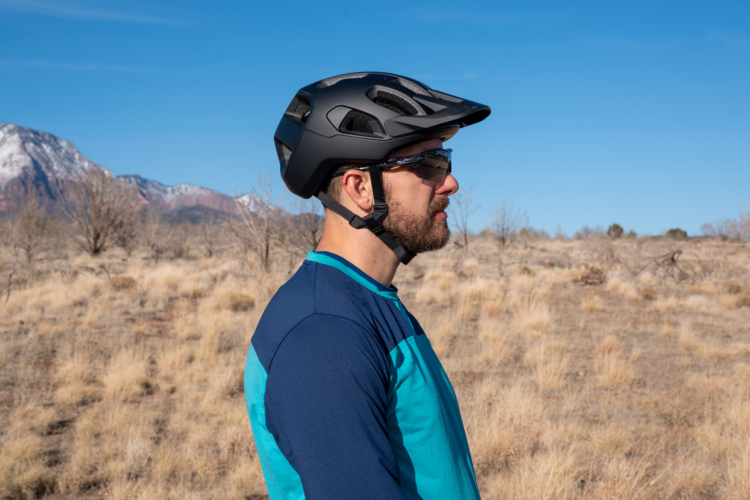
In a state with some of the best mountain biking in the country, the trails at Devil’s Den State Park offer a new, uniquely awesome experience.
The trails are loaded with challenging, purpose-built rock features, super-fast technical descents, flow trails, and high-pucker-factor drops. What sets Devil’s Den apart are the scenic bluffs, waterfalls, and other hidden natural gems to which riders are exposed. It’s a world not normally visited from the seat of a bicycle.
Devil’s Den trails are the fourth network in the Monument Trail collection constructed in state parks by Arkansas Parks & Recreation Foundation (APRF).
As Suzanne Grobmyer, APRF executive director, explained, the goal of Monument Trails is to construct trails that will “encourage visitors not just to ride the trail, but to take in everything natural the area offers.”
Mission accomplished!
APRF recruited Rock Solid Trail Contracting to help realize their vision for the park. In the fall of 2020, before Rock Solid turned the first spade of dirt, they scoured the steep hillsides of the 2,200-acre park. With input from Ozark Off-Road Cyclists and park staff members’ past explorations, they discovered picturesque bluffs, interesting rock formations, and other unique natural landscapes.
Aaron Rogers, owner of Rock Solid, challenged his crew to create a network of trails to access these features. They knocked it out of the ballpark.
Let’s ride
The additional twelve miles of Monument trails bumped the park’s mileage to nineteen miles of prime mountain bike trails. That’s more than enough to justify a designation as a “mountain bike destination.”
The Devil’s Den Adventure begins at the western border of the park. Continue past the Horse Campground on State Highway 220 and the bridge over Ellis Branch to reach Devil’s Racetrack Trail.
Currently, there is only a small pullout for parking. Tim Scott, Assistant Superintendent at Devil’s Den, announced that by August 2022, there would be camping, parking, bathrooms, and changing rooms at the trailhead.
From there, smooth singletrack meanders across a flat, open meadow, making for a good warmup. It then crosses the highway and a historic rock Civilian Conservation Corps era bridge, before gradually inching its way up to the base of a bluff line.
At this point, cyclists begin to experience the signature Devil’s Den vibe that sets it apart from other trails.
The Racetrack trail skirts the base of a sheer 100-foot bluff. As the trail ambles from under the high up, overhanging cliffs, riders are often gifted with a refreshing splash of water droplets from the drip line above. Pretty cool.
At just under four miles in length, Racetrack is the longest trail in the Monument network. When riders emerge from the bluff line, things get a little techie. The trail snakes its way between narrow passageways, under house-sized boulders wedged between narrow crevices, and over long, armor-plated rockways laid down by Rock Solid.
As riders pedal around a tight rocky ridge, boom! A 30-foot waterfall cascades over the edge of a horseshoe alcove. The trail routes you through, then behind, this curtain of water.
Riders next jump on a sweet stretch of Fossil Flats, the original trail network, to connect with Dollar-A-Day. The ride becomes a little more open and flowy on this gentle downhill grade. Fast-track this stretch for speed to take advantage, just for the fun of it, of the fun “secret” lines Rock Solid sprinkled in.

Riders might get a little wet crossing Lee Creek. Normally this is the drier of two crossings, but the deep collection of small, polished pebbles in the creek bed tends to suck at your knobbies and result in a wet foot dab.
Pedaling up the bank on the opposite shore, riders reach an intersection. Those preferring a short flat ride back to camp can hop on Sawmill Loop. But if you’re up for climbing, techie rocky stuff, and lots of “Oh shit!” moments, peel left for “All You Can Eat.”
Scott explained how the Monument Trail names were inspired by common expressions used by the Conservation Corps workers who built the park in the 1930s. Workers were paid “a dollar a day” and “all you can eat.”
Mountain bikers gain several hundred feet of elevation up All You Can Eat. Sweeping switchbacks cut into the mountainside and riders hardly notice they are climbing. Just kidding — but it isn’t that bad of a climb.
The trail tops out along the base of another bluff line, where rock-bordered passageways get a little snugger than those on Racetrack, and pathways become chunkier. With low-hanging jagged rock ledges bordering the trail, a little close for comfort, I was thankful to be only six-foot tall.
Now, it’s decision time: Will it be Sparky, an intermediate downhill with steep rocky descents and alternate line drops, plus another waterfall encounter? Or Orville, where Rock Solid’s skillful engineering and craftsmanship are at their best, incorporating the mountain’s raw materials into drops, natural and manmade armored flow lines, and other legit black diamond features?

Rogers explained Orville was designed to meet the park’s request to create a downhill run longer than those currently found on northwest Arkansas trails. At a minimum they wanted a 90-second descent, loaded with drops, gnarly rock features, and other challenging structures that test a bicycle’s suspension and handling. Their goal was to entice bike companies to bring their bikes here to be tested.
Both trails are one-way, bike-only trails, with no worries about close encounters of the uphill kind. So, lower your dropper, hang onto your bar grips, and let gravity do its thing.
Hardcore downhillers will enjoy mastering both super-rad trails by sessioning on the short return route back to the top.
From the stories Scott shared about the mischievous CCC worker Orville Taylor’s activities, it seems fitting to name the park’s only black diamond trail, Orville. One story told how Taylor convinced each of his barrack mates to pay him ten cents to rise early enough in the morning to stoke the fireplace so the cold room would be warm when they climbed out of bed.
Not just for mountain bikers

Don’t leave the family at home on your Devil’s Den Adventure. Even if they aren’t riding knobbies they will love this park.
Be it bike or hike, everyone will enjoy following the trails to get up close and personal with the bluff ledges, rock crevices, waterfalls, and expansive views into Lee Creek hollow from vantage points high on bordering ridges. At a slower hiking pace, they can read the kiosks distributed throughout that tell about the park’s role in Arkansas history.
After a fun-filled day of biking and hiking, load the troupe into the family truckster for a short, 30-mile drive to the eclectic City of Fayetteville. Everyone will appreciate the selection of eateries, craft breweries, and outdoor patio seating to celebrate the day’s festivities.
Scott is pleased with the new Monument Trails and that the park is once again setting the trend for mountain bike trails in the state.
It was Scott, along with his supervisor at the time Wally Scherr, who were responsible for Devil’s Den being known as “the birthplace of mountain biking” in the Natural State.
Together, in 1988, they attended the Fat Tire Mountain Bike Festival in Crested Butte, Colorado. After the visit, they decided the hilly, rocky environment at Devil’s Den was a perfect fit for mountain biking. The next year, the park hosted Arkansas’ first mountain bike festival, the Bentonville Bike Fest Ozark Mountain Bike Festival, and on the following day, the state’s first mountain bike race, now known as the Arkansas Mountain Bike Championship Series. The rest of the story, as they say, is history.
Both continue to be popular annual events to this day.























3 Comments
Feb 22, 2022
Feb 23, 2022
Feb 28, 2022